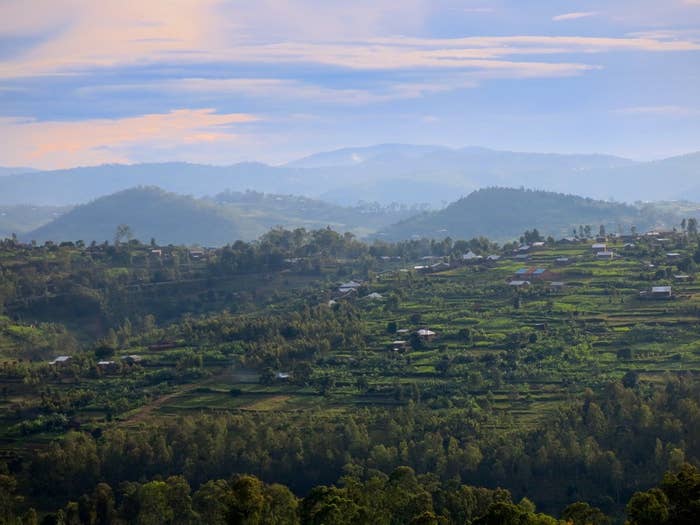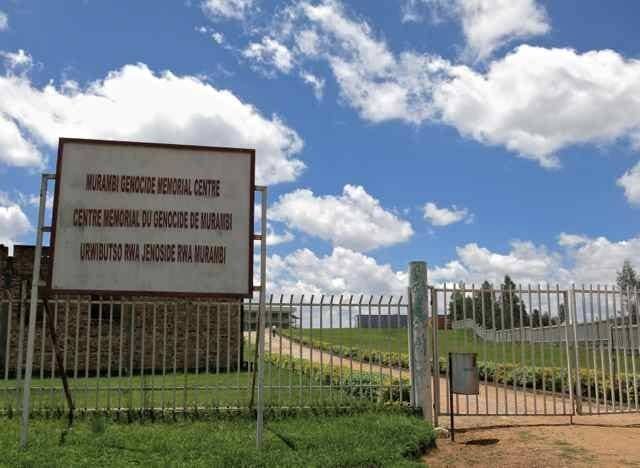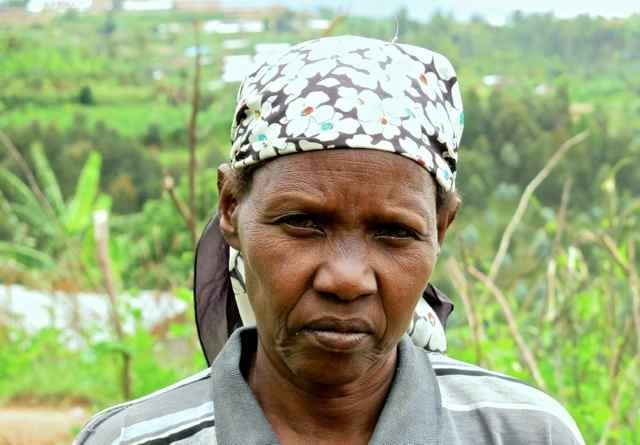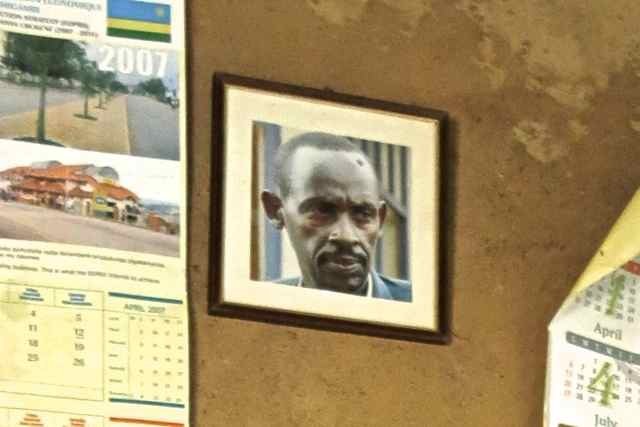
NYAMAGABE, Rwanda — There was never a day that Emmanuel Murangira didn't want to be with the bodies.
Not that he spent all day, every day at Murambi, the hilltop in Nyamagabe District, in rural Rwanda, where his family was killed in the 1994 genocide. He might idle, chatting with friends at a crossroads, pulling on a cigarette, or enjoying a Mutzig beer. But until the last year of his life, little could keep Murangira away from the job he had appointed himself to do, sweeping, litter-plucking, and keeping the bodies dry.
The bodies — there are over a hundred — make Murambi perhaps the most visually arresting of Rwanda's many genocide memorials. They are men and women and children of the genocide, their last moments preserved. Some skulls still have hair; some wrists still wear rosary beads; some arms still clutch loved ones.
They are also evidence, Murangira always argued — a retort to anyone who might argue that the genocide didn't happen.
It did, of course. In the early minutes of April 7, the plane of Rwanda's then-president, Juvenal Habyarimana, was shot down as it tried to land at the airport in Kigali, the capital. Habyarimana was a Hutu, and his army had fought a civil war with the Rwandan Patriotic Front, a Tutsi rebel force led by Paul Kagame. The two armies had signed a peace agreement, and the United Nations had sent troops to monitor a ceasefire.
But when Habyarimana's plane went down, roadblocks went up across Kigali. Anyone wanting to pass was stopped by soldiers or policemen or interahamwe, Hutu militias of mostly young men trained to kill, close up, with machetes. Identity cards were demanded, and anyone labeled by the state as a Tutsi was murdered.
The genocide spread across the country, reaching the tranquil hills of a rural Nyamagabe in the third week of April. Tutsis fled to churches, as they had during waves of ethnic slaughter in the past — in 1959, and 1963, and 1973, and, in some places in the country, in 1990 and 1993.
But in 1994, even churches weren't safe. Across the country, Tutsis were murdered where they prayed. In Nyamagabe, priests and mayors and other local leaders told the Tutsis to flee the churches and go instead to Murambi. High on that hilltop, the Tutsis were told, they'd be safe.
They believed it, if only because their sheer numbers were intimidating. As many as 50,000 people gathered on that hilltop. "We were so many, we thought, 'No one can kill us here,'" one survivor remembers.
And at first, no one could. The interahamwe came with machetes and clubs, but the Tutsis fought them back with sticks and stones. On April 21, the army reinforced the youth militia, and soldiers opened fire and lobbed grenades at the Tutsis. Many fell; the interahamwe moved through the bodies, urging each other to "finish the work," hacking to death anyone whom bullets hadn't already killed.
The bullets hadn't killed Emmanuel Murangira. Though one dove into his skull, leaving an indentation that never healed, he managed to escape Murambi. He walked roughly 100 kilometers to Burundi. At a hospital — precisely where, precisely when, he didn't remember so well — a doctor pulled the bullet from his skull. He recuperated. He heard on the radio that Kagame's army had taken control of much of the country, ending the genocide. A week later, he went home to Rwanda.
A year later, in June 1995, he returned to Nyamagabe. He wanted to find other survivors. He hoped his sister, who had been married to a Hutu, might be among them.
He found no one from his family. He himself found only a handful of other survivors of Murambi (though the official count, by the National Commission Against Genocide, is 13). He was consumed by anger, and he sneered at any Hutu he passed. "You are a killer," he would say. "You are a killer."
And he started spending his days with the dead.

Murambi has a special hold on the imagination of Rwanda's visitors. In 2004, the Aegis Trust, a British organization that helped to organize Rwanda's national memorial museum, announced plans for a memorial site and prevention center at Murambi. "Like Auschwitz and Hiroshima which preceded it," the Trust wrote on its website, "Murambi will also, in its own way, come to have symbolic meaning with far-reaching effects."
For outsiders, it's difficult to stand before corpses and not think about symbolic meaning. For all visitors, lessons will be inveighed and history imparted at official commemoration programs as Rwanda marks the 20th anniversary of the genocide. The world pays attention to round numbers, and hundreds of visitors have come to Rwanda to join in the moment.
But for Mary Mujawamariya, Murambi and its meaning are not abstract. She'd fled to the hilltop with her husband, and she ran from it with him too. He was shot literally in front of her in a sorghum field. As his body dropped, so did she, taking cover from the bullets. She stayed there for three nights. "I hid like a chicken with my head under the grass," she remembers. "It was important not to see the awful things that were happening. If you can die anytime, it's better not to see."
Mujawamariya tells her story with her whole body. She mimics the sounds of bullets, the slash of machetes, the terrifying things that she heard. She tucks her hands under the grass mat she sits on to show how she hid herself in the fields; she puts her hands on her shoulders to show how she prepared for death when she thought it had found her. She doesn't often tell her story, or visit Murambi — though she'd like to go on commemoration day, it's too packed with VIPs. When she speaks, she inhabits her history, in a way that suggests she's still traumatized.
There are no counselors here for Mujawamariya. Though there are various resources for survivors in Rwanda, none reach the hillside where Mujawarmariya is tucked away, alone. She's 60 years old. She never remarried, never had more children. When she's not letting out rooms in the house a nongovernmental organization built for her, she has no one to help her fetch water or get food.
Some days, she wants to be with the bodies too. "Sometimes I feel I want to go there, take some clothes, and lay there" — she pulls a colorful patterned kitenge cloth over her head and shoulders — "and just die."

Keeping the bodies takes care. Murangira gave it. In the early days, the bodies smelled so badly that no one but Murangira would go to Murambi. A poor man with little to spare, he nevertheless kept a spare shirt and pair of pants there, because the smell soaked into his clothes.
Then, in 1997 as he remembered it, someone showed him how to dust the bones with lime a few times a week, to preserve them and reduce the smell. He closed the iron doors of the classrooms tight when the rains came, and he aired them out after. He minded the humidity, and when the bodies would sweat, he would wipe them dry.
And then, sometimes, he would sit with them.
He knew they probably weren't the bodies of his own family — his wife, or his five children, or any of the other nearly 40 people he lost there. He knows they are not his sister, because he found out where she died during gacaca, the local "grass courts" that tried more than a million people for genocide. He reburied her at Murambi, in 2007, a moment that his wife, Olive Musengayire, says gave him great joy. "Because it's not good if you don't bury your dead."
But Murangira — like his wife, and like other survivors of Murambi and elsewhere I've talked to — thought the bodies on display were different. "My main objective was to make sure the bodies are preserved so that … strangers from other countries can see, because many people deny genocide happened in this country. That is evidence."
In 2004, a British organization received a half-million dollars to set up a permanent exhibition and archive space at Murambi. Other donors have followed, including to a project to preserve the corpses in clear acrylic coffins. Today, Murambi is visitor-friendly, tended by English-speaking guides, survivors of other massacres, who can talk knowledgeably about the national history of the genocide and the events that led up to it.

Murangira couldn't speak anything but Kinyarwanda, and he didn't have much of a mind for what happened in the rest of the country in 1994. But he knew Murambi intimately, and more than anyone else, he is the reason Murambi is known. In 1994, he watched as the dead were bulldozed into mass graves, marked the place in his mind, and insisted, when he returned, that the government exhume the bodies to prove what had happened in that place.
And he went to Murambi every day to make sure others remembered. If he'd heard visitors were coming, he would wait for them at Murambi. He became well-known among foreigners, who told his story word of mouth, and often people would arrive at Murambi asking for him by name and leave him with a few thousand francs, maybe $5 or $6, in his pocket.
He put some of that money into his favorite things: He liked to drink, and he liked to smoke. Above all he loved history — he would abandon the bottle early on Sundays and Mondays to be home in time to hear Igitaramo, a radio program about Rwanda's kings and myths and legends — but he needed a beer to make the day complete. "It wasn't often, but if he missed [money for] a beer, those who he bought beer would see he had no beer and buy one for him," Musengayire remembers. "Everybody knew him. He had friends all over."
He also became internationally known. He was in documentary films, on the covers of books, in newspaper articles. His is the face, the story, countless foreign visitors know. "The testimony he gave from the beginning is the same testimony the guides are giving today," Musengayire says.
But by the time Murambi became a sophisticated symbol, Murangira had gotten sick. He stopped working at Murambi in late 2010 or early 2011 (he and his wife remembered different dates). "I'm old. I'm weak. I can't even go dig in the field. They suggest I sleep and stay at home," he told me in March 2011.
But he couldn't stay away. His wife took over his cleaning duties, but he'd follow her there. "I could go early in the morning, thinking I'd left him sleeping, and all of the sudden, I'd see him there, visiting," she says.
He'd go to the second building, to the fourth or fifth classroom, and sit. "It's because those people are very tall, and the brother of his father was also tall, and he thought, 'Maybe they're the ones…'" she remembers. "He could go there, sit for 10 minutes, and then go home."
That lasted only a few months. In November 2011, Murangira died of lung cancer.
Eight months before he died, I interviewed Murangira again. He was worried about Murambi. "My main objective is to make sure the memorial stands. Today it's not as complete as I expected it to be," he said. "If it's completed as expected, it'll be my own joy."
Today, his objective is close to completion. The exhibit is open, and the preservation project well under way will preserve the bodies for years to come, as he hoped.
But the other things Murangira said he needed — things that survivors like 60-year-old Mujawamariya still need — are harder to find, things that could lighten agahinda, the word that comes up in so many survivors' stories, a marrow-deep kind of sorrow that only decreases, never disappears.
"If you had people who were able to give you some counseling, and if you had something to eat," Murangira told me in 2011, then the month of April could be easier. "But if you have nothing to eat and you're poor and you're hungry, and you think about all this, it can bring you trauma."
